Do not rush to bury "Angara", "East" and Roskosmos
June 9 marks a year, as the Proton does not fly, while in New Zealand a new private rocket was launched with a wide use of new technologies , and in the USA they showed a giant aircraft for launching space rockets using the air launch method. SpaceX tested the Falcon Heavy steps before the first launch, scheduled for late summer, and the Angara missile version was canceled at Vostochny. If another accident does not happen (and hoping for a competitor to fail is stupid), one private company, SpaceX, has chances to make more launches in 2017 than the entire Roscosmos. If you wish, you can make an excellent propaganda campaign from such a selection of facts: “everything is gone, the Angara is the end, the Eastern is the end, and the entire Russian space program is also the end.” But, if you think about it, the situation is more complicated and interesting than the poster slogan.
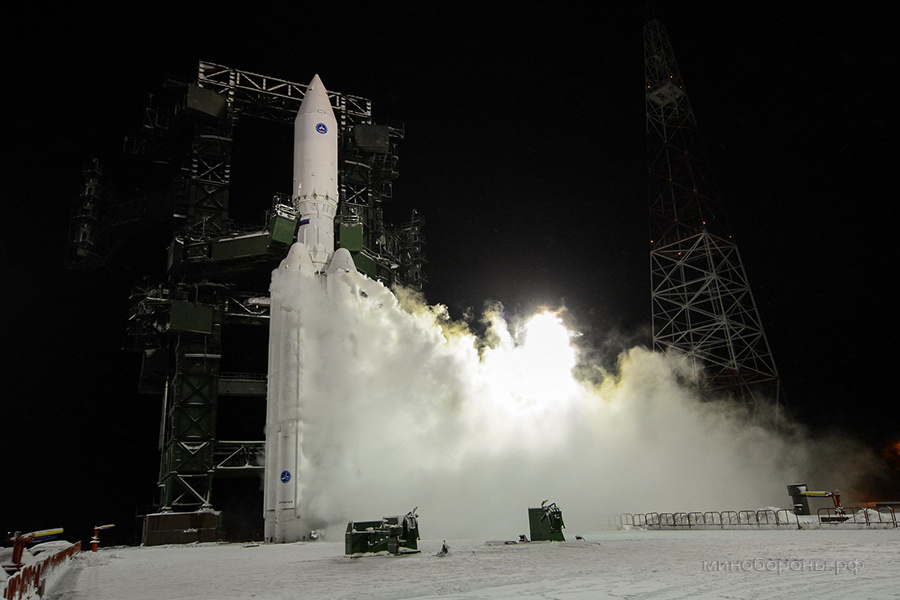
The news of the cancellation of the manned "Angara" on the "East" caused a large number of comments. This was written by journalists, popularizers, workers in the industry ( one , two , three , four , five , six , seven ). With such an abundance of opinions, I even thought not to express my own, but, first, several people directly asked to write about it, and second, I do not agree with all the comments above.
It would be nice to have an ideal booster. So that it could be universal , it could output both light and heavy satellites, in a special modification on it it would be possible to fly to the Moon, and at the same time it would also cost a penny. No one has yet solved this task, so it is not known what characteristics such a rocket should have and what ideology should be built. At the same time, each carrier has a manufacturing company that seeks to lobby its interests and prove that it is its solution that is the best. The hard fate of "Angara" will become clearer if you keep in mind these two factors.
The idea of "Angara" appeared in the 90s, when after the collapse of the USSR, Baikonur suddenly found himself on the territory of another state. Kazakhstan could prevent the launch of Russian satellites, so there was a need for a new heavy rocket, starting from its territory (transferring Proton to a new place is not rational for environmental reasons). In the Plesetsk there was an unused start of the Zenith, and there was no money in the budget, so the first version of the Angara was developed for the existing start and because of this, it was forced to have a very original design with side dump tanks. But due to lack of funds, the original project was not implemented, and the opportunity to change it appeared. According to the new idea, the rocket should have become modular and assembled from identical blocks — universal missile modules of the URM. With one unit, its payload would be 2 or 3.8 tons, and it would replace Cosmos-3M, which last launched in 2013 and light conversion rockets. With three URMs, 15 tons could be put into space, and this rocket could replace the Zenith, which was already experiencing problems due to production being torn apart in two countries. With 5 blocks and 25 tons into low earth orbit, a replacement for Proton would have been obtained. And the heaviest version with 7 blocks could bring 36 tons to a low orbit, and a few launches could have built a “train” to the moon. And due to the fact that universal modules would be produced in series, they had to be cheap.
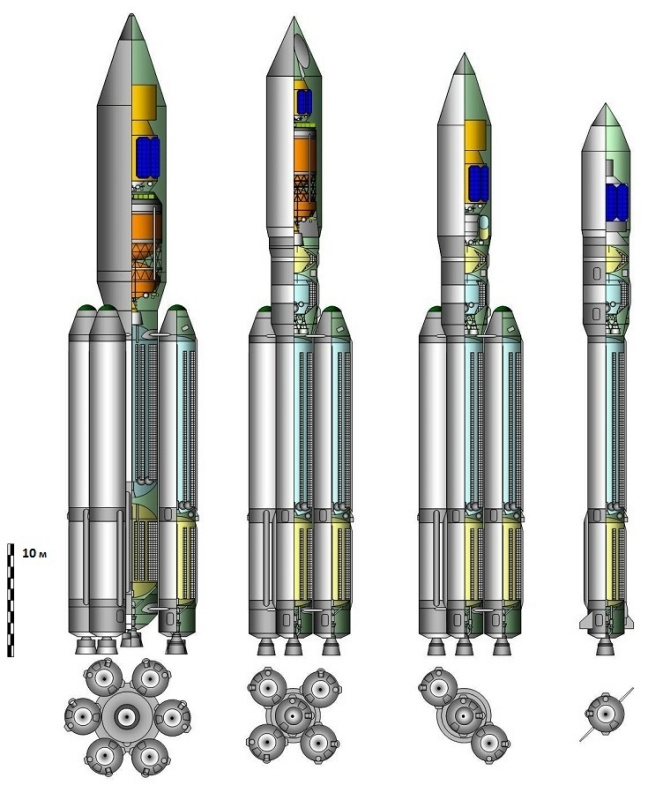
The scheme was not without flaws. Because of the different arrangement of the side blocks, the A7 variant required a separate starting complex or a transition block similar to the “Block I” of the RN Energia. And due to the fact that the small size of the URM was chosen, the maximum capacity of the "designer" turned out to be relatively small. For this, "Angara" was cursed by enthusiasts of superheavy rockets and expeditions to the moon.
The expected weight of the ship "Federation" is from 12 to 16 tons in different versions, and it would be logical to display it on the three-block version A3. But for some reason the “Federation” didn’t fit there, and the A5 variant, which in the A5P version should have a load capacity of around 18 tons, was adapted to the manned version. At the same time, due to the incompatibility of the start, variant A7 was missing. Instead, the idea arose to create a large hydrogen third stage and install it on a five-block version. Hydrogen A5V should have a load capacity in the region of the same 35 tons as the fully oxygen-kerosene A7.
In the zero years at the "Angara" Center. Khrunicheva was a competitor - the launch vehicle "Rus-M" from the Samara-based TsSKB-Progress. The rocket was built according to the same scheme, but the size of the URM was larger, and the single-block variant could lift 6.5 tons into orbit, and the heaviest five-block could be 50 tons.
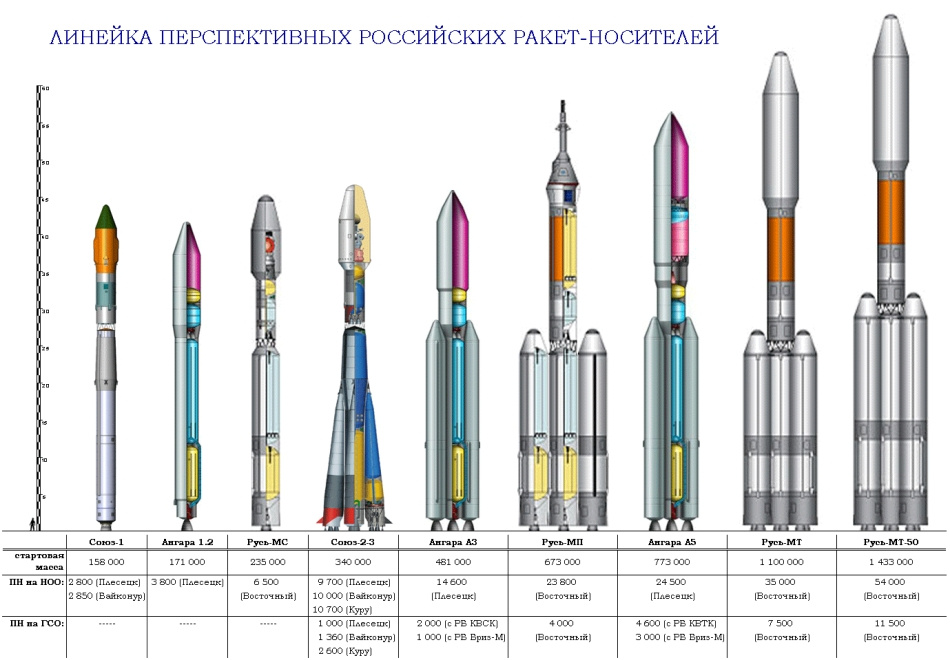
Then "TsSKB-Progress" lost, and in 2011, "Rus-M" officially closed. By the beginning of the 2010s, the imperfect, but quite well-structured scheme turned out to be - the “Proton” changes to A5 by 2025, the light rockets are switching to A1, the A3 was unclaimed, and in the long run to go to the moon, overclocking blocks with four launches of the heavy “Angara”, which will start from the “Vostochny”, including in the manned version. Alas, over time, the harmony of the scheme was broken.
At the end of 2013, six months before the first launch of the Angara A1, its direct competitor, Soyuz-2.1v , flew. After the successful debut of the light and heavy "Angara" in 2014, there were no more than two years of launch, and due to the fact that the transfer of production to Omsk still could not end, in April of this year there was news that the next launch " Angara "moved to 2018. At the Center. Khrunichev found serious problems , and the competitors did not yawn - because of the history of improper solder, the Voronezh Mechanical Plant, which the engines made, was transferred from the Center to them. Khrunichev at NPO Energomash, a subsidiary of RSC Energia. At the same time, it turned out that state space agencies and private companies began to engage in massively heavy-weight missiles. And from the "Angara" super heavy rocket, I recall, did not work at all. "The Old Man" Proton, formally still doomed to close in 2025, finally decided to get a lightweight and cheaper version. The Department of Commercial Space Transportation of the Federal Aviation Administration of the United States considered that one launch of a heavy Angara would cost $ 100 million compared to 65 Proton and 61.2 Falcon 9. S7 bought Sea Launch, which needs a Zenit missile "(Actually closed) or equivalent. And here it was just the time for the Phoenix rocket to appear, it’s also “Sunkar”, it ’s recently “Soyuz-5”, which was developed at least since 2015 , only few people paid attention to this. And the freshest cherry on the cake - the press service of the company “Yuzhmash” stated that it had already signed a contract for the production of 12 Zenits for S7, according to the words of the head of Roscosmos Igor Komarov at the Sea Launch St. Petersburg International Economic Forum recently will work with Soyuz-5. It is not surprising that, against the background of such news, analysts and forecasts stand on end, and instead of moving in one direction, the Russian space program has many options at once.
What can be said about the decision to cancel the manned Angara A5P? First of all, no one is going to bury “Angar” as a whole. She loses the monopoly of the only rocket for the future, but it is not scary. Yes, instead of four starting complexes there will be two, but from the “East” “Angara” it does not disappear, and, according to Dmitry Rogozin, will go on a flight in 2021. Further, it is not necessary to throw out money, breaking what we would have already done in this area. It seems that the ingenious RSC Energia quietly developed the Federation for Phoenix, so that in its project the modifications will be minimal (if any). And finally, at Baikonur, there really are launch sites for the Zenit launch vehicle with service towers, which were built under the manned version of Zenith with the Zarya spacecraft.
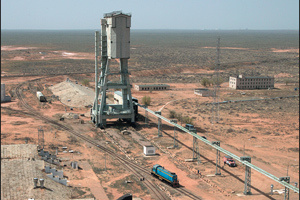
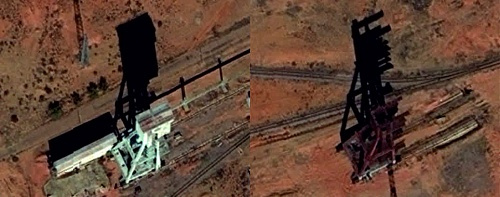
Yes, of course, they will need to be refined for a new rocket, but it really should be cheaper than building a large start with two towers from under the manned Angar from scratch.
At the end of April last year, I told with numbers and diagrams why we needed the Vostochny space center. In short, this is an analogue of Baikonur for launches into the geostationary orbit from its territory. In addition, his task is similar to the strategic concept of fleet-in-being , when only by its existence it shows that Russia cannot be blackmailed with access to Baikonur. Vostochny has certainly influenced today's improvement of relations with Kazakhstan in the space sector. But relations between countries are changing, and to have an alternative, even if they do not run anything from it, is very useful. And launches from Vostochny will be, by the end of 2017 two are planned, then more. Plesetsk and Baikonur may well work together, despite the fact that, for example, satellites are brought to the polar orbit from both space centers, so there will be enough work for three space centers as well. The new convenient service tower at Vostochny is a serious argument for moving at least some of the satellites there, and the Baikonur launch complexes will continue to launch Soyuz and Progress to the ISS.
When Angara was the main rocket for the future, the news about its possible deployment at the Sea Launch was quite interesting. Today there is another intrigue - whether Zenith can be reborn, and how it will compete with Soyuz-5 in five years. At the same time, we should not forget that the first attempt to organize launches from the Sea Launch ended in bankruptcy. I am delighted with the enthusiasm for space by the general director of the S7 Group, Vladislav Filev, and honestly wish him every success, but you must understand that space is a complex thing, very difficult to make a profit, and there were dozens of those who were less fortunate for successful private companies.
The sketch project "Soyuz-5" will be released only this year, however, already now you can find just such a picture of an unknown authorship.

It will be very interesting to see how the totals will differ. "Zenith", "Soyuz-5" and Falcon-9 - twin brothers in design, and they can be compared almost directly. And if the characteristics of the illustrations are real, then this will be very bad news. Mu Mon (ratio of payload to initial mass) shows the mass perfection of the launch vehicle. And smaller mu Mon with the best oxygen-kerosene engines will mean a serious degradation of our design and production schools.
I tried to present possible options for the future that might await the Russian cosmonautics.
Scenario one: "Everything is going according to plan."
The necessary conditions:
Results:
During 2018-2025, fewer “Protons” and more and more Angara A5 rockets fly. The Soyuz-5, which appeared in 2022, is not a direct competitor to the heavy Angara. With 17 tons to a low orbit, from Baikonur to a geotransfer, it will output tons 4, while Angara from Vostochny can take 25 tons to a low orbit and around 7 tons to a geotransition (Proton) 6.45 tons in 2016). Soyuz-5 launches the Federation into low orbit, which may well have time to catch the ISS, especially if it is extended beyond 2024. In the second half of the 20s, a super-heavy rocket of three blocks is assembled at the Soyuz-5 base, for which you will need to build a separate start. On it you can go to fly around the moon one launch or land on the moon in two starts. Or, if the project of a super-heavy rocket is not being implemented (this is very big money in the absence of commercial payloads), you can assemble a lunar fly-by or landing ship for 2 (circled) or 4 (disembarking) launches of the Soyuz-5 and Angara.
Scenario two: “Russian Delta-4”.
The necessary conditions:
Results:
"Angara" becomes a rocket, which is only needed by the military. Less than five times a year (or rather, one or two), it displays military satellites. In this form, it has no future, and in the 2020s, it will somehow cease to exist. Here, the main issues are the competitiveness of the Proton and Soyuz-5. If “Proton” fails to compete, then the future of the whole Center becomes extremely sad for them. Khrunichev. The Progress TsSKB does not disappear anywhere already flying “Unions-2”, so their position is better even in the case of
failure of the "Union-5". If Soyuz-5 succeeds, it can become one of the main launch vehicles of the second quarter of the 21st century in Russia, taking astronauts and payloads from Baikonur and the Sea Launch.
Scenario Three: "Stagnation."
The necessary conditions:
As a result, the year 2024 (the last contractual year of operation of the ISS), Russian cosmonautics meets the same "Protons" and "Soyuz-2", which are flying now. The situation is not catastrophic, but very unpleasant - other countries and private companies will not stand still, for commercial launches on the international market it will be more difficult to compete, and as a result Russian cosmonautics will shrink greatly in size to the level of a regional power with a pragmatic unmanned cosmonautics only for themselves .
To which of the scenarios the real future will come closer, we will be able to find out only in a few years.
As for the comparative news, from which the publication began, in the near future there will be only small reasons to rejoice. For example, the Proton will have to return to flights on June 8, so we most likely will not celebrate the anniversary without start-up, and on July 14, the Mayak satellite will finally have to go along with Canopus-V-IC.

Small preface
The news of the cancellation of the manned "Angara" on the "East" caused a large number of comments. This was written by journalists, popularizers, workers in the industry ( one , two , three , four , five , six , seven ). With such an abundance of opinions, I even thought not to express my own, but, first, several people directly asked to write about it, and second, I do not agree with all the comments above.
Dreams of a perfect rocket on the background of the battle of the giants
It would be nice to have an ideal booster. So that it could be universal , it could output both light and heavy satellites, in a special modification on it it would be possible to fly to the Moon, and at the same time it would also cost a penny. No one has yet solved this task, so it is not known what characteristics such a rocket should have and what ideology should be built. At the same time, each carrier has a manufacturing company that seeks to lobby its interests and prove that it is its solution that is the best. The hard fate of "Angara" will become clearer if you keep in mind these two factors.
The idea of "Angara" appeared in the 90s, when after the collapse of the USSR, Baikonur suddenly found himself on the territory of another state. Kazakhstan could prevent the launch of Russian satellites, so there was a need for a new heavy rocket, starting from its territory (transferring Proton to a new place is not rational for environmental reasons). In the Plesetsk there was an unused start of the Zenith, and there was no money in the budget, so the first version of the Angara was developed for the existing start and because of this, it was forced to have a very original design with side dump tanks. But due to lack of funds, the original project was not implemented, and the opportunity to change it appeared. According to the new idea, the rocket should have become modular and assembled from identical blocks — universal missile modules of the URM. With one unit, its payload would be 2 or 3.8 tons, and it would replace Cosmos-3M, which last launched in 2013 and light conversion rockets. With three URMs, 15 tons could be put into space, and this rocket could replace the Zenith, which was already experiencing problems due to production being torn apart in two countries. With 5 blocks and 25 tons into low earth orbit, a replacement for Proton would have been obtained. And the heaviest version with 7 blocks could bring 36 tons to a low orbit, and a few launches could have built a “train” to the moon. And due to the fact that universal modules would be produced in series, they had to be cheap.

The scheme was not without flaws. Because of the different arrangement of the side blocks, the A7 variant required a separate starting complex or a transition block similar to the “Block I” of the RN Energia. And due to the fact that the small size of the URM was chosen, the maximum capacity of the "designer" turned out to be relatively small. For this, "Angara" was cursed by enthusiasts of superheavy rockets and expeditions to the moon.
The expected weight of the ship "Federation" is from 12 to 16 tons in different versions, and it would be logical to display it on the three-block version A3. But for some reason the “Federation” didn’t fit there, and the A5 variant, which in the A5P version should have a load capacity of around 18 tons, was adapted to the manned version. At the same time, due to the incompatibility of the start, variant A7 was missing. Instead, the idea arose to create a large hydrogen third stage and install it on a five-block version. Hydrogen A5V should have a load capacity in the region of the same 35 tons as the fully oxygen-kerosene A7.
In the zero years at the "Angara" Center. Khrunicheva was a competitor - the launch vehicle "Rus-M" from the Samara-based TsSKB-Progress. The rocket was built according to the same scheme, but the size of the URM was larger, and the single-block variant could lift 6.5 tons into orbit, and the heaviest five-block could be 50 tons.

Then "TsSKB-Progress" lost, and in 2011, "Rus-M" officially closed. By the beginning of the 2010s, the imperfect, but quite well-structured scheme turned out to be - the “Proton” changes to A5 by 2025, the light rockets are switching to A1, the A3 was unclaimed, and in the long run to go to the moon, overclocking blocks with four launches of the heavy “Angara”, which will start from the “Vostochny”, including in the manned version. Alas, over time, the harmony of the scheme was broken.
Prowling Phoenix, Hidden Proton, Resurrected Zenith
At the end of 2013, six months before the first launch of the Angara A1, its direct competitor, Soyuz-2.1v , flew. After the successful debut of the light and heavy "Angara" in 2014, there were no more than two years of launch, and due to the fact that the transfer of production to Omsk still could not end, in April of this year there was news that the next launch " Angara "moved to 2018. At the Center. Khrunichev found serious problems , and the competitors did not yawn - because of the history of improper solder, the Voronezh Mechanical Plant, which the engines made, was transferred from the Center to them. Khrunichev at NPO Energomash, a subsidiary of RSC Energia. At the same time, it turned out that state space agencies and private companies began to engage in massively heavy-weight missiles. And from the "Angara" super heavy rocket, I recall, did not work at all. "The Old Man" Proton, formally still doomed to close in 2025, finally decided to get a lightweight and cheaper version. The Department of Commercial Space Transportation of the Federal Aviation Administration of the United States considered that one launch of a heavy Angara would cost $ 100 million compared to 65 Proton and 61.2 Falcon 9. S7 bought Sea Launch, which needs a Zenit missile "(Actually closed) or equivalent. And here it was just the time for the Phoenix rocket to appear, it’s also “Sunkar”, it ’s recently “Soyuz-5”, which was developed at least since 2015 , only few people paid attention to this. And the freshest cherry on the cake - the press service of the company “Yuzhmash” stated that it had already signed a contract for the production of 12 Zenits for S7, according to the words of the head of Roscosmos Igor Komarov at the Sea Launch St. Petersburg International Economic Forum recently will work with Soyuz-5. It is not surprising that, against the background of such news, analysts and forecasts stand on end, and instead of moving in one direction, the Russian space program has many options at once.
Early panic
What can be said about the decision to cancel the manned Angara A5P? First of all, no one is going to bury “Angar” as a whole. She loses the monopoly of the only rocket for the future, but it is not scary. Yes, instead of four starting complexes there will be two, but from the “East” “Angara” it does not disappear, and, according to Dmitry Rogozin, will go on a flight in 2021. Further, it is not necessary to throw out money, breaking what we would have already done in this area. It seems that the ingenious RSC Energia quietly developed the Federation for Phoenix, so that in its project the modifications will be minimal (if any). And finally, at Baikonur, there really are launch sites for the Zenit launch vehicle with service towers, which were built under the manned version of Zenith with the Zarya spacecraft.


Yes, of course, they will need to be refined for a new rocket, but it really should be cheaper than building a large start with two towers from under the manned Angar from scratch.
A little bit about the "East"
At the end of April last year, I told with numbers and diagrams why we needed the Vostochny space center. In short, this is an analogue of Baikonur for launches into the geostationary orbit from its territory. In addition, his task is similar to the strategic concept of fleet-in-being , when only by its existence it shows that Russia cannot be blackmailed with access to Baikonur. Vostochny has certainly influenced today's improvement of relations with Kazakhstan in the space sector. But relations between countries are changing, and to have an alternative, even if they do not run anything from it, is very useful. And launches from Vostochny will be, by the end of 2017 two are planned, then more. Plesetsk and Baikonur may well work together, despite the fact that, for example, satellites are brought to the polar orbit from both space centers, so there will be enough work for three space centers as well. The new convenient service tower at Vostochny is a serious argument for moving at least some of the satellites there, and the Baikonur launch complexes will continue to launch Soyuz and Progress to the ISS.
Sea Launch
When Angara was the main rocket for the future, the news about its possible deployment at the Sea Launch was quite interesting. Today there is another intrigue - whether Zenith can be reborn, and how it will compete with Soyuz-5 in five years. At the same time, we should not forget that the first attempt to organize launches from the Sea Launch ended in bankruptcy. I am delighted with the enthusiasm for space by the general director of the S7 Group, Vladislav Filev, and honestly wish him every success, but you must understand that space is a complex thing, very difficult to make a profit, and there were dozens of those who were less fortunate for successful private companies.
"Soyuz-5"
The sketch project "Soyuz-5" will be released only this year, however, already now you can find just such a picture of an unknown authorship.

It will be very interesting to see how the totals will differ. "Zenith", "Soyuz-5" and Falcon-9 - twin brothers in design, and they can be compared almost directly. And if the characteristics of the illustrations are real, then this will be very bad news. Mu Mon (ratio of payload to initial mass) shows the mass perfection of the launch vehicle. And smaller mu Mon with the best oxygen-kerosene engines will mean a serious degradation of our design and production schools.
Roads, roads
I tried to present possible options for the future that might await the Russian cosmonautics.
Scenario one: "Everything is going according to plan."
The necessary conditions:
- It is possible to adjust the production of "Angara" at the plant in Omsk. The probability of this is very high, but since this event has not yet come, it is not one hundred percent.
- "Angara" is cost-effective. The real cost of starting option A5, until they become regular, can only be assumed, and an estimate of $ 100 million could easily be erroneous.
Results:
During 2018-2025, fewer “Protons” and more and more Angara A5 rockets fly. The Soyuz-5, which appeared in 2022, is not a direct competitor to the heavy Angara. With 17 tons to a low orbit, from Baikonur to a geotransfer, it will output tons 4, while Angara from Vostochny can take 25 tons to a low orbit and around 7 tons to a geotransition (Proton) 6.45 tons in 2016). Soyuz-5 launches the Federation into low orbit, which may well have time to catch the ISS, especially if it is extended beyond 2024. In the second half of the 20s, a super-heavy rocket of three blocks is assembled at the Soyuz-5 base, for which you will need to build a separate start. On it you can go to fly around the moon one launch or land on the moon in two starts. Or, if the project of a super-heavy rocket is not being implemented (this is very big money in the absence of commercial payloads), you can assemble a lunar fly-by or landing ship for 2 (circled) or 4 (disembarking) launches of the Soyuz-5 and Angara.
Scenario two: “Russian Delta-4”.
The necessary conditions:
- Angara is unable to compete for commercial payloads.
Results:
"Angara" becomes a rocket, which is only needed by the military. Less than five times a year (or rather, one or two), it displays military satellites. In this form, it has no future, and in the 2020s, it will somehow cease to exist. Here, the main issues are the competitiveness of the Proton and Soyuz-5. If “Proton” fails to compete, then the future of the whole Center becomes extremely sad for them. Khrunichev. The Progress TsSKB does not disappear anywhere already flying “Unions-2”, so their position is better even in the case of
failure of the "Union-5". If Soyuz-5 succeeds, it can become one of the main launch vehicles of the second quarter of the 21st century in Russia, taking astronauts and payloads from Baikonur and the Sea Launch.
Scenario Three: "Stagnation."
The necessary conditions:
- The deadlines for the Angara and Phoenix programs are constantly shifted to the right, or the leapfrog of various projects begins. In Plesetsk, the built launch pad quietly rusts, on Vostochniy, rust is also unfinished.
As a result, the year 2024 (the last contractual year of operation of the ISS), Russian cosmonautics meets the same "Protons" and "Soyuz-2", which are flying now. The situation is not catastrophic, but very unpleasant - other countries and private companies will not stand still, for commercial launches on the international market it will be more difficult to compete, and as a result Russian cosmonautics will shrink greatly in size to the level of a regional power with a pragmatic unmanned cosmonautics only for themselves .
To which of the scenarios the real future will come closer, we will be able to find out only in a few years.
As for the comparative news, from which the publication began, in the near future there will be only small reasons to rejoice. For example, the Proton will have to return to flights on June 8, so we most likely will not celebrate the anniversary without start-up, and on July 14, the Mayak satellite will finally have to go along with Canopus-V-IC.
All Articles